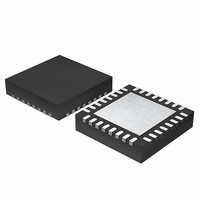EFM32G200F64 Energy Micro, EFM32G200F64 Datasheet - Page 227

EFM32G200F64
Manufacturer Part Number
EFM32G200F64
Description
MCU 32BIT 64KB FLASH 32-QFN
Manufacturer
Energy Micro
Series
Geckor
Datasheets
1.EFM32G200F16.pdf
(63 pages)
2.EFM32G200F16.pdf
(10 pages)
3.EFM32G200F16.pdf
(463 pages)
4.EFM32G200F16.pdf
(136 pages)
Specifications of EFM32G200F64
Core Processor
ARM® Cortex-M3™
Core Size
32-Bit
Speed
32MHz
Connectivity
EBI/EMI, I²C, IrDA, SmartCard, SPI, UART/USART
Peripherals
Brown-out Detect/Reset, DMA, POR, PWM, WDT
Number Of I /o
24
Program Memory Size
64KB (64K x 8)
Program Memory Type
FLASH
Ram Size
16K x 8
Voltage - Supply (vcc/vdd)
1.8 V ~ 3.8 V
Data Converters
A/D 4x12b, D/A 1x12b
Oscillator Type
External
Operating Temperature
-40°C ~ 85°C
Package / Case
32-VQFN Exposed Pad
Processor Series
EFM32G200
Core
ARM Cortex-M3
Data Bus Width
32 bit
Data Ram Size
16 KB
Interface Type
I2C, UART
Maximum Clock Frequency
32 MHz
Number Of Programmable I/os
24
Number Of Timers
2
Operating Supply Voltage
1.8 V to 3.8 V
Maximum Operating Temperature
+ 85 C
Mounting Style
SMD/SMT
Minimum Operating Temperature
- 40 C
Lead Free Status / RoHS Status
Lead free / RoHS Compliant
Eeprom Size
-
Lead Free Status / Rohs Status
Details
Available stocks
Company
Part Number
Manufacturer
Quantity
Price
- EFM32G200F16 PDF datasheet
- EFM32G200F16 PDF datasheet #2
- EFM32G200F16 PDF datasheet #3
- EFM32G200F16 PDF datasheet #4
- Current page: 227 of 463
- Download datasheet (8Mb)
18.3.8 Transmission Delay
18.3.9 DMA Support
18.3.10 Pulse Generator/ Pulse Extender
2010-09-06 - d0001_Rev1.00
By configuring TXDELAY in LEUARTn_CTRL, the transmitter can be forced to wait a number of bit-
periods from it is ready to transmit data, to it actually transmits the data. This delay is only applied to the
first frame transmitted after the transmitter has been idle. When transmitting frames back-to-back the
delay is not introduced between the transmitted frames.
This is useful on half duplex buses, because the receiver always returns received frames to software
during the first stop-bit. The bus may still be driven for up to 3 baud periods, depending on the current
frame format. Using the transmission delay, a transmission can be started when a frame is received,
and it is possible to make sure that the transmitter does not begin driving the output before the frame
on the bus is completely transmitted.
The LEUART has full DMA support in energy modes EM0 – EM2. The DMA controller can write to the
transmit buffer using the registers LEUARTn_TXDATA and LEUARTn_TXDATAX, and it can read from
receive buffer using the registers LEUARTn_RXDATA and LEUARTn_RXDATAX. This enables single
byte transfers and 9 bit data + control/status bits transfers both to and from the LEUART. The DMA will
start up the HFRCO and run from this when it is waken by the LEUART in EM2. The HFRCO is disabled
once the transaction is done.
A request for the DMA controller to read from the receive buffer can come from one of the following
sources:
• Receive buffer full
A write request can come from one of the following sources:
• Transmit buffer and shift register empty. No data to send.
• Transmit buffer empty
In some cases, it may be sensible to temporarily stop DMA access to the LEUART when a parity or
framing error has occurred. This is enabled by setting ERRSDMA in LEUARTn_CTRL. When this bit is
set, the DMA controller will not get requests from the receive buffer if a framing error or parity error is
detected in the received byte. The ERRSDMA bit applies only to the RX DMA.
When operating in EM2, the DMA controller must be powered up in order to perform the transfer. This
is automatically performed for read operations if RXDMAWU in LEUARTn_CTRL is set and for write
operations if TXDMAWU in LEUARTn_CTRL is set. To make sure the DMA controller still transfers bits
to and from the LEUART in low energy modes, these bits must thus be configured accordingly.
Note
The LEUART has an optional pulse generator for the transmitter output, and a pulse extender on the
receiver input. These are enabled by setting PULSEEN in LEUARTn_PULSECTRL, and with INV in
LEUARTn_CTRL set, they will change the output/intput format of the LEUART from NRZ to RZI as
shown in Figure 18.7 (p. 228) .
When RXDMAWU or TXDMAWU is set, the system will not be able to go to EM2/EM3
before all related LEUART DMA requests have been processed. This means that if
RXDMAWU is set and the LEUART receives a frame, the system will not be able to go to
EM2/EM3 before the frame has been read from the LEUART. In order for the system to go
to EM2 during the last byte transmission, LEUART_CTRL_TXDMAWU must be cleared in
the DMA interrupt service routine. This is because TXBL will be high during that last byte
transfer.
...the world's most energy friendly microcontrollers
227
www.energymicro.com
Related parts for EFM32G200F64
Image
Part Number
Description
Manufacturer
Datasheet
Request
R

Part Number:
Description:
KIT STARTER EFM32 GECKO
Manufacturer:
Energy Micro
Datasheet:

Part Number:
Description:
KIT DEV EFM32 GECKO LCD SUPPORT
Manufacturer:
Energy Micro
Datasheet:

Part Number:
Description:
BOARD PROTOTYPING FOR EFM32
Manufacturer:
Energy Micro
Datasheet:

Part Number:
Description:
KIT DEVELOPMENT EFM32 GECKO
Manufacturer:
Energy Micro
Datasheet:

Part Number:
Description:
MCU, MPU & DSP Development Tools TG840 Sample Kit
Manufacturer:
Energy Micro
Datasheet:

Part Number:
Description:
MCU, MPU & DSP Development Tools TG Starter Kit
Manufacturer:
Energy Micro
Datasheet:

Part Number:
Description:
MCU, MPU & DSP Development Tools TG108 Sample Kit
Manufacturer:
Energy Micro

Part Number:
Description:
MCU, MPU & DSP Development Tools TG210 Sample Kit
Manufacturer:
Energy Micro
Datasheet:

Part Number:
Description:
MCU, MPU & DSP Development Tools TG822 Sample Kit
Manufacturer:
Energy Micro
Datasheet:

Part Number:
Description:
MCU, MPU & DSP Development Tools TG230 Sample Kit
Manufacturer:
Energy Micro

Part Number:
Description:
SAMPLE KIT (SMALL BOX - CONTAINING 2 DEVICES)
Manufacturer:
Energy Micro

Part Number:
Description:
SAMPLE KIT (SMALL BOX - CONTAINING 2 DEVICES)
Manufacturer:
Energy Micro











